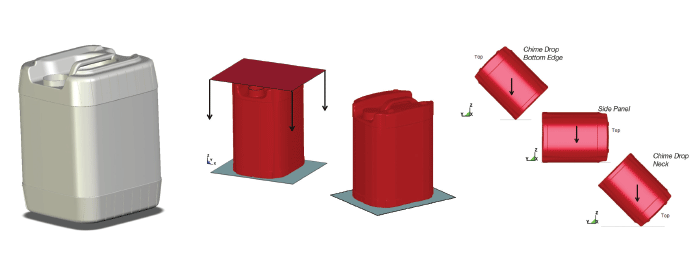Kinetic Vision engineers partnered with KLW Plastics to test integration of modeling and simulation into their product development and testing workflow.
KLW Plastics, a leading designer, manufacturer and distributor of containers, recently partnered with Kinetic Vision and the Ohio Supercomputer Center to evaluate the effectiveness of advanced modeling and simulation technologies to optimize its container products by lightening their weight, while maintaining the required strength. The partnership arose through the federal National Digital Engineering and Manufacturing Consortium (NDEMC) program, a public-private partnership funded by the U.S. Economic Development Administration to support and enhance the use of modeling and simulation among America’s small and medium manufacturers.
“Pursuit of a higher standard in containers is part of our everyday work here,” said Tom Gruber, national sales manager for KLW, based in Monroe, Ohio. “Our state-of-the-art manufacturing technology, our research and development efforts, product design, raw material sourcing, our production process and testing contribute to a highly consistent and reliable final product.”
KLW was using 3-D CAD applications on desktop systems prior to the NDEMC program, but had not yet integrated modeling and simulation into their product development and testing workflow. Through the NDEMC partnership, Cincinnati product design and development firm Kinetic Vision worked with the engineering team at KLW to capture computerized tomography (CT) data of one of their signature blow-mold containers.
The team then fed the data into OSC’s Oakley HP-Intel Xeon cluster to compute and evaluate finite element models of the tight-head container using the LS-DYNA software package. The project built upon and fully validated the company’s virtual top-load, pressure and drop tests using current production KLW packaging.
“Developing validated advanced simulation models through the collaboration of Ohio-based companies, the Ohio Supercomputer Center and technologies like industrial CT is making manufacturers more competitive in the global market place,” said Jim Topich, director of engineering of Kinetic Vision.
KLW identified two additional long-term benefits of the simulations: 1) a better understanding of how to utilize advanced modeling and simulation prototyping resources prior to cutting expensive new molds, and 2) improved predictions of container performance using different thickness distributions. Lessons learned from this project should lead to substantial cost savings for the company by reducing the weight of the containers, while maintaining reliability.
“Our idea is to be as advanced as we can and set good ways to doing business in an industry that is very stagnant,” Gruber said. “We’re trying to make waves.”
Project Lead: Jim Topich, Kinetic Vision
Research Title: Design optimization of plastic containers
Funding Source: National Digital Engineering and Manufacturing Consortium
Website: http://kinetic-vision.com/about-us/

